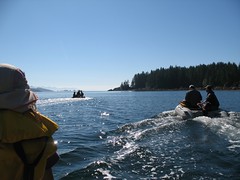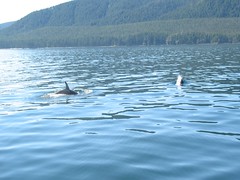The trip was roughly 35 nautical miles if you followed the coast line from Winter Harbor, across to Cape Cook, around Brooks Peninsula, and over to the tuck into beautiful little Columbia Cove. Other than rounding Cape Scott, this trip around Brooks Peninsula is considered by many to be the hairiest part of any passage up or down the west coast of Vancouver Island.
Brooks is a thumb of land pushing into the Pacific like a hitch hiker grabbing the nearest earthly plate to drift northwards. Apparently, this nearly square jut of land is the only part of Vancouver not covered by glaciers during the last ice age. It stands several thousand feet tall and funnels the prevailing summer northeasterly in a vicious hook around Cape Cook and Solander Island where winds are routinely 30 to 40 and at least 10 to 15 higher than everywhere else.
As a result, we all timed the weather window carefully, hanging on hooks in or near Winter Harbor for a few days until satisfied with the reports off Solander and South Brooks. The sail boats were, of course, the first to leave the harbors. We swarmed out of Quatsino Sound, little pickup sticks bouncing vertically on the waves as we coalesced from north and west towards our course at the first waypoint off Kwakiutl Point. The wind freshened inexplicably from the east to 15 and the horizon sparkled with the handkerchief dots of main sails and jibs happily taking advantage of the beam reach for the first leg.
Just as all our sails went up, the power boaters steamed by thumping out cross wakes which were immediately lost in the developing chop created by an easterly wind and a northwesterly swell. Their objectives were no doubt considerably more ambitious than our own, bypassing the hidden coves of South Brooks entirely and heading deep into the friendly harbors and calm waters of Kyuquot Channel. There was also the practical consideration of the weather report. Winds nasty in the morning, dying off mid day, returning with a vengeance in late afternoon. Our p/v compatriots were simply getting while the getting was good.
We, however, were sailing into a fog bank as the winds shifted finally to their usual northwest and picked up to 20. The seas were only 2 meters. Only. The girls and I are complete noobs in the world of oceanic voyaging so six feet of steep wave with white caps was both intimidating and sickening. One by one, the girls went down with gimpy tummy. No one tossed anything smelly, but I settled them all down with blankies, stuffed animals, and motherly love, and they promptly followed the body’s most useful defense against seasickness -- they passed out. This left Dr C and I on the deck with no company. All the other boats, the shore, and the horizon were lost in a dense blanket of mist.
I said 35 miles, right? But that was, of course, assuming we followed the coast line. We never follow the coast line. We never follow a straight line. We are a sail boat, so of course the wind never permits us to travel the shortest distance. Instead, we headed off into the deep blue in a course somewhat orthogonal to our destination. The winds were cold and wet, the skies grey, the water slate and dusted with spray. Tracking via the chart plotter, backed up by our handheld GPS and chart, was the only indicator we were making progress. It all looked the same. Seas high and choppy, steep waves with short periods, wind steady 23 gusting occasionally to 30. Dr C kept reassuring me that it could be so much worse. We headed out out out into the ocean, then finally tacked and headed back back back to the unseen coastline.
One mile before the chart insisted we’d duck behind Brooks on the last leg of our journey, the sun suddenly made an appearance, the headland loomed above us, and the water began to sparkle. A half mile later, the winds dipped to 14, and the chop disappeared. Another mile and we were well into the shelter of Brooks, the winds died to 5, and the swell disappeared. Even shaking out reefs didn’t help, and the motor went on. We were so hot we started shedding clothing, stripping the covers off the bimini, and turning on the fans.
Another mile behind the peninsula and the blow holes started spouting in every direction. The girls, fully recovered from nap and mal de mer, swarmed over the deck shouting and pointing. Dr C throttled back as a large pod of orcas herded fish past us and towards the shore. At one point a trio headed straight for the boat, blowing not 10 yards from our starboard bow. The girls bounced on the tramp as the beasts passed under them before emerging for air again 20 yards off the port. Fins were visible in every direction, tails occasionally flapped the water, and one broached and jumped partially out of the water. Dr C idled forward after their passage only to be brought up short again, this time by a pair of humpbacks. These were much much larger and much slower. They seemed to enjoy looking at our boat, and spent a good five minutes showing their humps as they circled us before moving on to something more interesting.
I took the helm threading our way into the microscopic dip in the shoreline that constitutes the Columbia Cove anchorage as Dr C and the girls continued their Discovery Channel moment on the bow. There, tucked between rock and headland, were our buddy boats s/v Indigo and s/v Mercedes. Like the orcas, dinghies flowed out from our friends towards our boat, greetings and invitations extended, and guidance on where to anchor proffered. Forty to fifty miles later through sail, gale and whale, it was time to settle in for sea stories and ale. Welcome home!



No comments:
Post a Comment